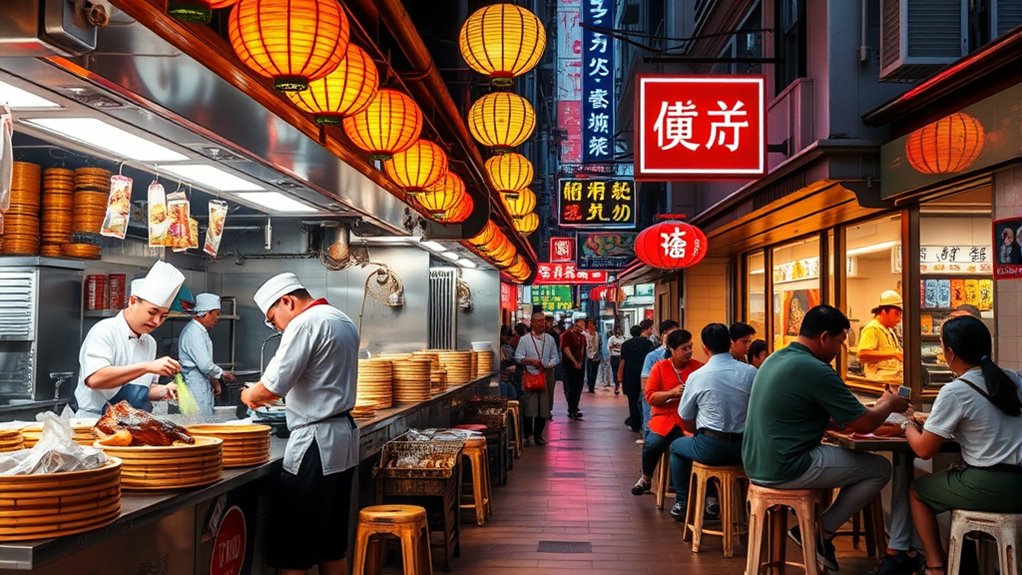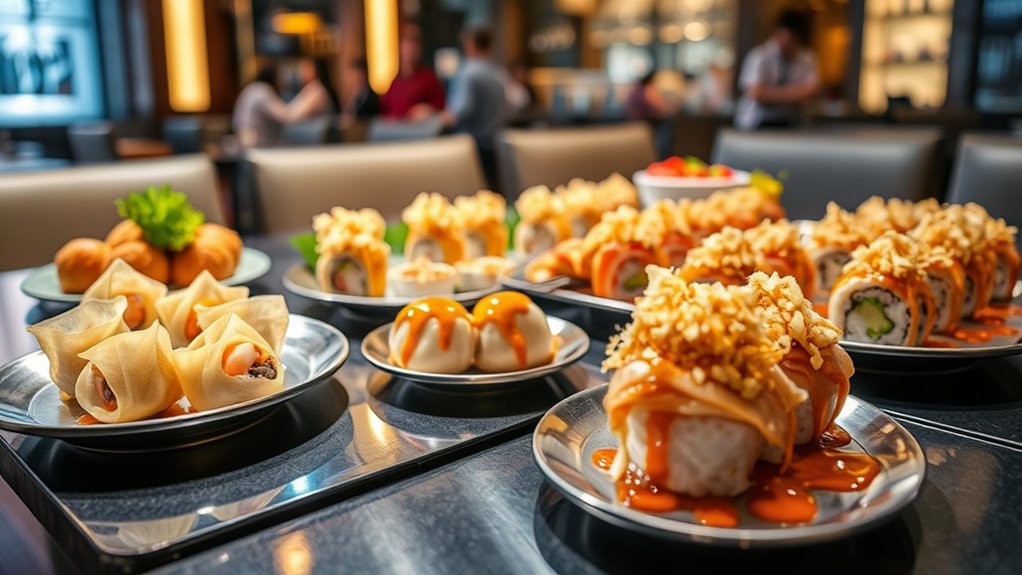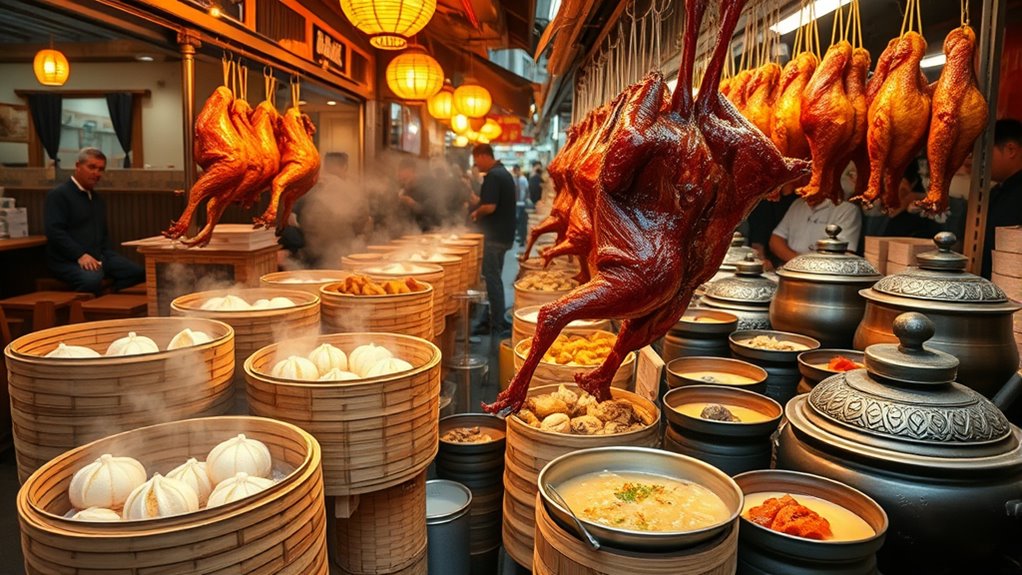Hong Kong’s cuisine blends Cantonese roots with colonial influences and modern innovation. You’ll find iconic dim sum, street foods like egg waffles, and seasonal dishes for celebrations like mooncakes. Flavors mix soy sauce, seafood, and herbs with international twists. Traditional eating customs focus on sharing and harmony, while globalization introduces diverse influences. If you want to explore how history and culture shape Hong Kong’s vibrant food scene, there’s much more to discover.
Key Takeaways
- Hong Kong cuisine originates from Cantonese traditions, enriched by British colonial influences and modern global flavors.
- Iconic dishes include dim sum, street snacks like egg waffles, and fusion creations blending Eastern and Western elements.
- Food rituals such as mooncakes and sticky rice cakes symbolize reunion, good fortune, and cultural continuity during festivals.
- Ingredients like century eggs, dried seafood, and Chinese herbs define Hong Kong’s distinctive flavors and culinary techniques.
- Contemporary trends emphasize fusion cuisine and international influences, reflecting Hong Kong’s vibrant, multicultural food scene.
Roots and Evolution of Hong Kong Cuisine

Hong Kong cuisine has evolved through a dynamic blend of cultural influences, rooted primarily in Cantonese traditions brought by migrants from Guangdong province in the early 20th century. These migrants introduced classic dishes like dim sum, wonton noodles, and roast meats, establishing a strong Cantonese foundation. During British colonial rule, Western flavors and techniques merged with local ingredients, creating unique hybrid dishes such as soy sauce Western cuisine. After 1997, Hong Kong’s culinary scene grew more cosmopolitan, incorporating Japanese, European, and Southeast Asian influences, especially among younger diners. The city’s status as a financial hub fueled culinary innovation, blending Eastern and Western methods. Over time, traditional practices adapted, resulting in a vibrant, diverse food culture that balances heritage with modern global trends. Understanding the culinary evolution helps appreciate how historical events and cultural exchanges shaped Hong Kong’s diverse food scene.
Iconic Dishes and Street Food Delights

You can’t visit Hong Kong without trying its must-have dim sum staples like har gow, siu mai, and char siu bao, which are served in traditional teahouses or modern cafes. Street snacks such as egg waffles, milk tea, and Swiss chicken wings offer quick, flavorful bites that capture the city’s vibrant street food scene. These dishes showcase Hong Kong’s rich culinary heritage and its love for combining tradition with innovation.
Must-Try Dim Sum Staples
Dim sum staples are the heart of Hong Kong’s culinary scene, offering a delicious array of bite-sized dishes that showcase Cantonese craftsmanship. You’ll find classics like har gow (shrimp dumplings), cheung fun (rice rolls), and char siu bao (barbecue pork buns) at many teahouses. These dishes are often served with fragrant jasmine tea and shared among friends or family. To highlight their importance, here’s a quick comparison:
| Dish | Key Ingredient |
|---|---|
| Har Gow | Shrimp, bamboo skin |
| Cheung Fun | Rice flour, shrimp or beef |
| Siu Mai | Pork, shrimp, mushroom |
| Char Siu Bao | Barbecue pork, soft bun |
These staples encapsulate the essence of Hong Kong’s dim sum culture—delicious, portable, and perfect for social dining. Culinary traditions play a vital role in preserving this vibrant food heritage.
Popular Street Snacks
Street snacks are the vibrant heartbeat of Hong Kong’s bustling food scene, offering quick, flavorful bites that locals and visitors alike grab on the go. You’ll find egg waffles, crispy and golden, perfect for a sweet treat while exploring city streets. Milk tea, rich and smooth, is a must-try beverage that pairs well with any snack. Hong Kong-style French toast, filled with peanut butter or kaya, is deep-fried until crispy, drizzled with syrup—a satisfying breakfast or snack. Don’t miss the iconic siu mai or shrimp dumplings, served steaming from street stalls or dai pai dongs. Swiss chicken wings marinated in soy, then fried to perfection, showcase the fusion of Eastern and Western flavors. These street snacks embody Hong Kong’s dynamic culinary identity—delicious, portable, and deeply rooted in local culture.
Key Ingredients and Distinct Flavors

Hong Kong cuisine is characterized by a rich palette of key ingredients and distinctive flavors that reflect its unique cultural blend. You’ll find century eggs and salted duck eggs adding depth and umami to many dishes, while Chinese cabbage, shiitake mushrooms, and gai lan provide fresh, earthy notes. Dried seafood like shrimp and scallops lend a savory richness, especially in celebratory meals. Rice and noodles are fundamental, serving as versatile staples that absorb flavors beautifully. Herbs and seasonal produce are carefully selected, often guided by traditional Chinese medicine principles. Fusion flavors also stand out, with soy sauce, Chinese sausage, and ox tripe integrating Western influences. These ingredients create a balanced, layered palate that defines Hong Kong’s vibrant culinary identity.
Dining Customs and Eating Habits

In Hong Kong, you’ll notice that people eat five small meals a day instead of three larger ones, often pairing main dishes with rice or noodles. Traditional dining practices emphasize sharing dishes, especially during dim sum or banquets, highlighting a communal approach to eating. Festive foods like mooncakes and sticky rice cakes play a key role during celebrations, reflecting the importance of seasonal and cultural customs in daily life.
Meal Frequency and Portions
Many Hong Kong residents follow a distinctive eating pattern that emphasizes frequent, smaller meals throughout the day. You might find yourself eating five times daily—breakfast, mid-morning snack, lunch, afternoon snack, and dinner—rather than three larger meals. Portions tend to be modest, reflecting a preference for light bites like dim sum or street snacks. This pattern supports a busy lifestyle, allowing you to enjoy a variety of flavors without feeling overly full. Meals often include rice or noodles as a base, paired with small portions of meat, seafood, or vegetables. Sharing dishes is common, especially during social gatherings or at dim sum, where multiple small plates are passed around. This approach keeps your energy steady and aligns with Hong Kong’s vibrant, fast-paced culinary culture. Many traditional dishes are designed to be enjoyed in small, shareable portions, emphasizing communal dining experiences.
Traditional Dining Practices
Traditional dining practices in Hong Kong emphasize harmony, respect, and shared experiences. As you dine, you’ll notice customs designed to foster connection and etiquette. Here are four key aspects:
- Sharing dishes – Meals are communal, with multiple dishes placed at the center for everyone to sample.
- Small portions – Portions are often smaller than Western standards, encouraging variety and conversation.
- Respectful manners – You’ll observe polite behaviors like waiting for elders to start eating and using chopsticks appropriately.
- Timing and rhythm – Meals are relaxed, often lasting longer, emphasizing social bonding over eating.
Additionally, the use of proper tableware enhances the dining experience and reflects cultural respect. These practices reflect the city’s blend of tradition and modernity, creating a dining experience rooted in respect and togetherness.
Festive Food Customs
Festive food customs in Hong Kong revolve around preparing and sharing special dishes that symbolize luck, unity, and prosperity. During festivals like Chinese New Year, you’ll enjoy dishes like sticky rice cakes, whole fish, and dumplings, each representing abundance and togetherness. Mooncakes are essential for the Mid-Autumn Festival, symbolizing family reunion and harmony. You often gather with family or friends for banquets, where small portions of dim sum or hot pot are common, emphasizing sharing. Seasonal ingredients, such as lotus seeds and jujube, are used for their health benefits and auspicious meanings. These foods aren’t just about taste—they’re deeply tied to cultural beliefs, making each meal during festivals a meaningful celebration of tradition, good fortune, and community.
Impact of Globalization and Contemporary Trends

Globalization has profoundly transformed Hong Kong’s culinary scene by introducing diverse international cuisines and innovative cooking techniques. You now see Japanese, Thai, and European flavors blending seamlessly with traditional Cantonese dishes. Here’s how it’s changing your dining experience:
Globalization blends international cuisines with Cantonese flavors, transforming Hong Kong’s vibrant dining scene.
- Ethnic restaurants proliferate, offering authentic tastes from around the world, catering to cosmopolitan tastes.
- Modern eateries like Little Bao and Yardbird reinterpret classic dishes with international twists, earning global acclaim.
- Fusion cuisine rises in popularity, combining soy sauce and Chinese ingredients with Western methods.
- Luxury ingredients like abalone and grouper become more accessible, driven by mainland Chinese demand, impacting traditional celebrations.
- The use of high-quality equipment for food presentation and preparation enhances the culinary experience, reflecting the importance of modern techniques in traditional settings.
These trends create a dynamic, evolving culinary landscape that balances tradition with global influences.
Seasonal Flavors and Festival Foods

As the seasons change in Hong Kong, so do the flavors and dishes that define its culinary calendar, with each festival inspiring specific foods that reflect cultural values and health principles. During spring, you’ll find fresh bamboo shoots and spring onions, aligning with festivals like Ching Ming. Summer offers herbal jellies, cooling desserts, and seasonal fruits such as lychee and watermelon. Autumn features mooncakes and warming soups for the Mid-Autumn Festival, symbolizing reunion. In winter, hot pot, ginger dishes, and sticky rice cakes for Chinese New Year take center stage. These foods are chosen not just for taste but for their health benefits, guided by traditional Chinese medicine. Cultivating an awareness of traditional health practices can deepen appreciation for these seasonal culinary choices.
Fusion Cuisine and Modern Innovation

Hong Kong’s culinary scene is continuously evolving through innovative fusion dishes that blend Eastern and Western flavors. You’ll find creative combinations that push boundaries and reflect the city’s cosmopolitan spirit. Here are four ways this innovation manifests:
- Fusion restaurants combine traditional Cantonese techniques with international ingredients, like sushi with Chinese sauces.
- Modern reinterpretations of street snacks, such as egg waffles infused with matcha or cheese.
- Chef-driven experiments that blend Western plating styles with Asian flavors, elevating casual dishes.
- Global influences such as Mediterranean spices in dim sum or tacos filled with Cantonese-style roast meats.
- These culinary innovations are supported by modern kitchen techniques, which enable chefs to experiment more freely and refine their creative dishes.
These innovations keep Hong Kong’s cuisine fresh, exciting, and reflective of its diverse, dynamic culture.
Traditional Food Rituals and Cultural Significance

Traditional food rituals in Hong Kong are deeply intertwined with cultural values and community life, serving as meaningful expressions of identity and heritage. When you participate in these customs, you honor centuries-old traditions that reinforce family bonds and social cohesion. For example, preparing and sharing mooncakes during the Mid-Autumn Festival symbolizes reunion and harmony, while the ceremony of offering sticky rice cakes during Chinese New Year signifies good fortune. Dim sum outings aren’t just about eating; they celebrate togetherness and respect for custom. Seasonal foods mark important festivals and shifts, reflecting beliefs in health and balance rooted in Chinese medicine. These rituals keep cultural stories alive, connecting generations through shared practices that honor history, community, and the enduring significance of food in Hong Kong’s cultural fabric. Additionally, understanding the symbolism behind traditional dishes enhances appreciation of their cultural importance and the emotional significance they carry across generations.
Frequently Asked Questions
How Has Hong Kong Cuisine Maintained Its Cantonese Roots Amid Global Influences?
You see that Hong Kong cuisine keeps its Cantonese roots alive through traditional dishes like dim sum, wonton noodles, and roasted meats, which remain central to daily dining. You’ll notice local ingredients such as Chinese sausage, salted eggs, and dried seafood, preserving authentic flavors. Despite global influences, the city’s focus on small portions, seasonal ingredients, and cultural festivals guarantees Cantonese culinary traditions stay vibrant and relevant.
What Are the Most Popular Street Foods Unique to Hong Kong?
You’ll find egg waffles and milk tea as symbols of Hong Kong’s vibrant street food scene. These treats, like tiny treasures, capture the city’s blend of tradition and innovation. As you savor crispy egg waffles or sip rich milk tea, you’re tasting a story of adaptability and cultural fusion. These iconic snacks reflect Hong Kong’s lively spirit—where old-world charm meets modern flair in every bite.
How Do Seasonal Ingredients Influence Hong Kong’s Traditional Dishes?
Seasonal ingredients heavily influence Hong Kong’s traditional dishes, guiding what locals enjoy throughout the year. During spring, you’ll find fresh bamboo shoots and spring onions in light, invigorating dishes. Summer brings herbal jellies and cooling soups like winter melon. Autumn features braised dishes and mooncakes, while winter emphasizes hot pots, ginger-based recipes, and festive foods like sticky rice cakes. These ingredients align with Chinese medicine principles, ensuring dishes are both flavorful and healthful.
In What Ways Do Modern Fusion Dishes Reflect Hong Kong’s Culinary Evolution?
You’ll notice that modern fusion dishes in Hong Kong cleverly mirror its culinary evolution, blending East and West with a wink. Instead of sticking to tradition, chefs mix soy sauce with truffle oil or reinterpret dim sum with global ingredients, showing that Hong Kong’s palate isn’t afraid to break rules. These dishes celebrate the city’s cosmopolitan spirit, proving that in Hong Kong, tradition and innovation dance cheek-to-cheek.
How Do Local Dining Customs Shape Daily Eating Patterns in Hong Kong?
You typically eat smaller, frequent meals throughout the day, often five times, which reflects Hong Kong’s dining customs. You might start your day with dim sum or local snacks like egg waffles and milk tea. Lunch and dinner are often quick, social affairs, with dishes like noodles or hot pot. During festivals, special foods like mooncakes or sticky rice cakes become central, emphasizing family and seasonal traditions in your eating habits.
Conclusion
As you explore Hong Kong’s culinary landscape, you’ll discover a vibrant tapestry woven with centuries of tradition and innovation. From iconic street foods to elegant fusion dishes, this cuisine is an unparalleled feast for the senses. Embrace the rich flavors, cultural rituals, and contemporary twists that make Hong Kong’s food scene truly legendary. It’s a culinary journey so extraordinary, it might just redefine your love for food forever.










